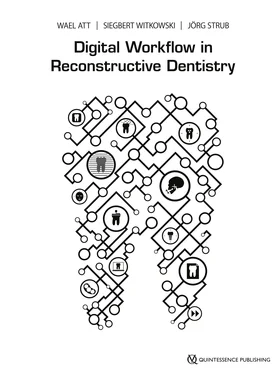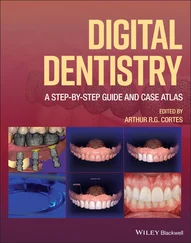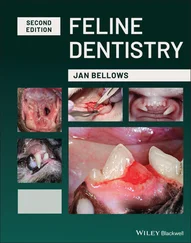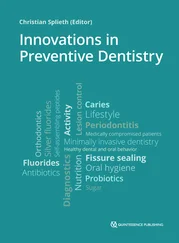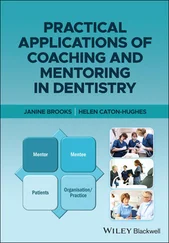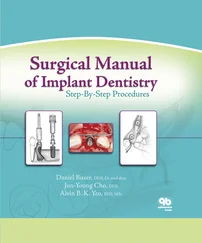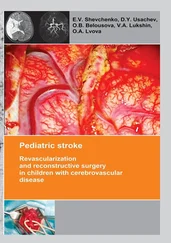This chapter will serve as a brief introduction to the components of digital dentistry and areas of implementation.
What is the Digital Workflow?
The digital workflow in reconstructive dentistry has been described by Att and Gerard (2014) 1as comprised of three main components; starting with data acquisition, followed by data processing and planning, and finally with the execution of treatment or fabrication ( Fig 1.1).
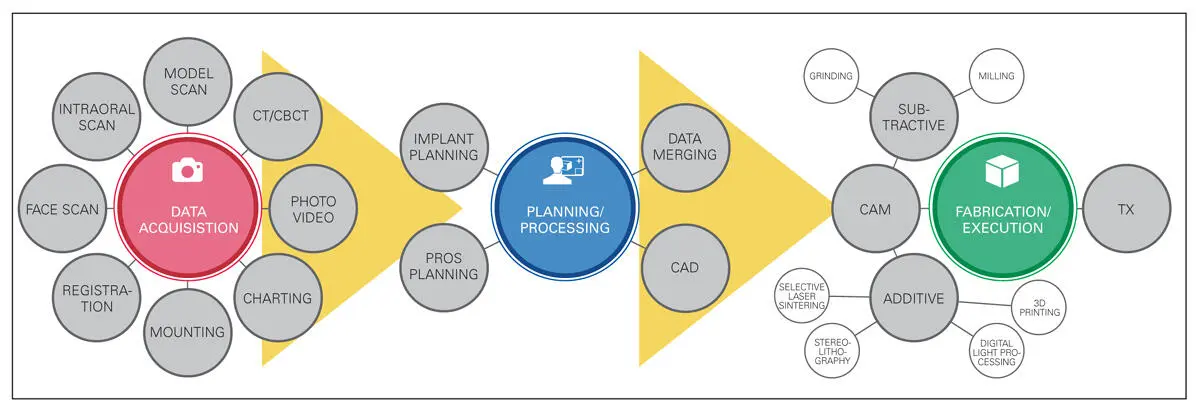
Fig 1.1Overview of the digital workflow in reconstructive dentistry. 1
For the first component “data acquisition,” there are many technologies available. The goal is to transform the patient’s information into digital data that can be used for further steps, such as analysis, treatment planning, and processing/planning. Some of the acquisition techniques available encompass digital charting, intraoral or desktop scanners, digital radiography, digital photography, video recordings, and so on. As an example, digital photography is considered an important acquisition tool. It is widely used today for documentation and communication purposes. Together with the appropriate software and online or cloud-based communication platforms, the photos can be used as a part of comprehensive treatment and esthetic analysis and, at the same time, as an important communication tool among the dentist, the dental lab, and the patient.
In cases of smile enhancement, for example, providing photos and videos of different stages of the rehabilitation (try-ins, mock-ups, and so on) helps the dental laboratory technician to optimize the esthetic reconstruction, thus reducing the in-office patient treatment time during try-in. On the other hand, the use of intraoral scanners to perform computer-assisted impressions is considered today as a predictable and a fast tool for the purpose of digitizing and manufacturing small-unit reconstructions.
The next step of the workflow encompasses “processing/planning” of the data acquired in order to set a treatment plan or design a restoration. One of the important aspects here is so-called data matching, where data sets obtained from different acquisition tools (e.g., intraoral scan and cone-beam computed tomography (CBCT) or patient photos superimposed onto model scans) can be merged/superimposed together using specific planning software in order to enhance the information for the dentist or lab technician on the computer screen. Most software companies are intensively working on introducing software that can combine more than two different data sets (e.g., surface scans of the intraoral situation, CBCT, face scan, jaw movement data, and so on). The ultimate goal is to create the completely virtual patient. Such a development would push the digital workflow at an even speedier pace and allow for faster adaptation by practitioners, technicians, and teachers. This topic is described elsewhere in this book.
For clarity in “treatment and fabrication,” it is important to mention that CAD/CAM is considered as a component of the digital workflow. Per definition, CAD is the use of a computer to assist in the creation, modification, analysis, or optimization of a design. CAD software is used to improve the productivity of the designer, the quality of the designs, and the communication through documentation as well as to create a database and a three-dimensional file for manufacturing. Once the CAD process is complete, the generated files are transferred to a local or a remote CAM solution. Here, a software and process are required to enable fully automated manufacturing of dental restorations by preparation of the generated CAD files for subtractive or additive manufacturing machines. While CAM has been successfully performed via subtractive techniques, the increased use of additive manufacturing technologies, such as 3D printing, stereolithography, selective laser sintering, and other methods is remarkable. Concepts related to the different components of the digital workflow that are being used on contemporary dental offices are briefly discussed in this chapter. The next chapters of this book provide an in-depth focus onto the different components of the digital workflow.
Data Acquisition
As already described, data acquisition is the first step of the digital workflow.
While many acquisition technologies exist, the most-used components are patient management systems, including dental charting software and radiography. While dental offices performing patient registration and “conventional” charting by means of paper form are becoming history, many dental offices and dental schools are using the digital approach using different commercially available software for Electronic Protected Health Information (ePHI). With such software, different patient data and information can be obtained and stored for later use.
Typically, medical and dental history as well as comprehensive charting, including radiographic analysis, can be stored. Large-scale clinics and institutions use network-based software that facilitates access of patient data from different working stations. However, concerns remain about patient privacy and data access. For these it is highly recommended to use software that guarantee patient information (i.e., which implement the ePHI). To facilitate this, the software are required to be compliant with the Health Insurance Portability and Accountability Act (HIPPA) in the United States or with the General Data Protection Regulation (GDPR) across the European union.
The goal is to protect all “individually identifiable health information” held or transmitted by a covered entity or its business associates, in any form or media, whether electronic, paper, or oral. “Individually identifiable health information” is information, including demographic data, that relates to (a) the individual’s past, present, or future physical or mental health or condition; (b) the provision of healthcare to the individual; or (c) the past, present, or future payment for the provision of healthcare to the individual; and that identifies the individual or for which there is a reasonable basis to believe it can be used to identify the individual. Individually identifiable health information includes many common identifiers (e.g., name, address, birth date, ID number, social security number, and so on). Further identifiers include, but are not limited to patient facial photographs, annotated/named radiographs, models, intraoral scan data, face scan data, or any other identifiable data. Therefore, it is important for all staff members of any clinic or institution to understand and implement patient privacy standards and guidelines.
Data Processing/Planning and Treatment Planning
While some software incorporate both acquisition and processing/planning capabilities, the majority of developers currently separate them in different software to avoid complexity and introduce clarity into the workflow. Data processing/planning software can be introduced by the same manufacturer of the acquisition device/tool or by another. A good example is the use of acquisition software for an intraoral scanner and CAD from the same device manufacturer (e.g., Sirona or 3Shape). Another possibility is to use processing/planning software that is developed by a different manufacturer than the acquisition software. An example here is the use of CBCT data obtained from a specific manufacturer and imported into implant planning software from a different developer. While this procedure is common, it is important to have the files/data prepared in universal way that the majority of the software can read. Here, the most commonly used universal file formats, among others, are Joint Photographic Experts Group (JPEG), Digital Imaging and Communications In Medicine (DICOM), Standard Tessellation Language (STL), Geometry Definition File Format (OBJ), Tagged Image File Format (TIFF), and Moving Picture Experts Group 4 (MP4). Whenever these files are the output by an acquisition software and can be easily imported and read by the processing/planning software, the workflow is considered as an open system. In the case where the output file is not universal, it must be read by a specific processing/planning software that is typically from the same acquisition device/software developer, so the system is considered to be closed. With some closed systems it is still possible to export the data in a universal format or, in other words, to convert from a closed to an open system. Here, the software developer typically charges fees for this conversion, termed as a click fee .
Читать дальше
